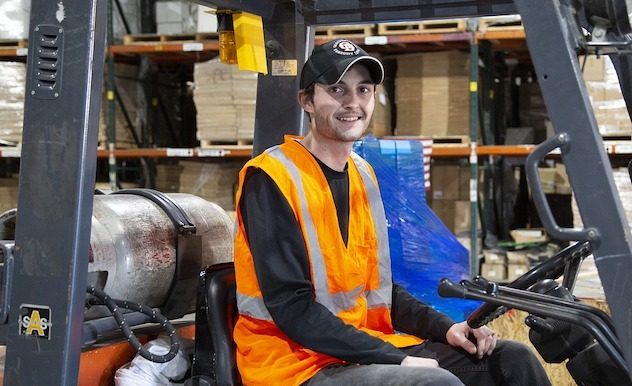We look at the challenges warehouse managers face when case picking and piece picking within the same warehouse, and the options available to them.
Traditionally warehouses that offered carton or case picking would specialise in this activity, with warehouse processes designed around ordering, picking and shipping whole cartons/cases.
However, these days many ‘case-picking warehouses’ are being asked to perform a second role, as businesses that previously functioned as wholesalers are increasingly shipping individual items direct to the public.
This development is driven by changes in consumer behaviour as well as economics. As adoption of e-commerce continues, consumers are becoming more and more comfortable ordering online. This includes items that they would have only bought from a store previously, such as foodstuffs.
This opens up opportunities for businesses that handle this stock – wholesalers and distribution centres – to shorten the supply chain and increase margins by selling directly to consumers.
What this means for the warehouse
Supporting both requirements presents challenges for warehouse staff, as they now need to serve two markets with very different profiles. This means adapting pick operations to handle both full case picking and broken case picking within one warehouse environment.
Fundamentally, warehouse managers have two methods to choose from; they can pick from either dedicated or shared locations. Both options have their own set of operational requirements, advantages and disadvantages, as we go on to highlight.
Case and piece packing from dedicated locations
The basic idea behind a dedicated locations approach is that cases/cartons and pieces for the same product are never picked from the same location.
Instead, if a piece pick is required and there is no stock in a piece location for the product, a replenishment operation will be required to move stock from the case/carton to the piece location. There’s never any need for a warehouse worker to split cases into pieces during the pick of a customer order.
Benefits of a dedicated locations approach
There are two main advantages to this approach. The first is simplicity, as it won’t take long for order pickers to understand that either carton or piece picks will be performed from a certain location in the warehouse, but never both.
An extremely important advantage is that there is less chance of an error occurring during the picking process – a much larger risk when picking from shared locations.
Drawbacks to a dedicated locations approach
Using dedicated locations does come with some disadvantages. The first is that you may need more locations.
Secondly, you’ll need additional replenishment operations to move stock to where it is needed, most often from carton to piece locations. If these operations are not set up and routinely performed, dispatch delays may arise.
Understandably, setting up dedicated locations and replenishment processes requires time and effort to set up and verify. However, once in place the ease of use can make up for this.
Case picking and piece picking from shared locations
The second option for dealing with a hybrid case/carton and piece picking is to use a shared zone for pallet picking and piece picking. A shared location in this context may contain stock for the same product in two or more units of measure.
With this approach, the warehouse management system (WMS) will attempt to assign small quantity picks to existing piece stock. When this is not available, the picking will take place from existing case stock.
When this happens, the system will need to prompt the warehouse operative to split cases during the pick itself. Effectively, case splitting will take place on demand where the stock is currently located.
Advantages of case picking and piece picking from shared locations
Zone picking involves fewer standalone warehouse processes, and there is no need for the warehouse manager to coordinate replenishment activity just to make cases available for piece picking.
Disadvantages of case picking and piece picking from shared locations
The price for this ‘convenience’ comes in a number of forms. Sophisticated software is required to support this approach. Although present on OrderFlow, it’s a feature that’s not available on many other WMS solutions.
The other disadvantage is that the warehouse operator’s job becomes harder. Each pick may be from a location that contains two (or sometimes more) units of measure for the same product. In a high volume environment, mistakes are easy to make, and for obvious reasons, errors can be costly.
In order to prevent errors from taking place, a number of strategies can be applied:
- Each unit of measure for a product should be individually barcoded so that it can be correctly detected via a single product scan. Without this, the operator may need to manually confirm the unit of measure used for each pick.
- Additional stock checking can be put in place for goods already picked to ensure that the correct quantity and unit of measure has been used for each product.
Without these strategies in place, the danger of mispicks is significant, with consequences that are potentially costly.
What’s the best picking method for your warehouse environment?
If your current warehouse management system supports picking of cartons/cases and pieces from the same location, starting off with this picking method may be tempting, and may make sense in some cases.
For example, if the overwhelming majority of picks is for a single unit of measure (either pieces or cases), then the effort to set up dedicated locations and processes may not be justified. A similar argument may be made for a warehouse that’s extremely space constrained.
If you continue down this route, you’ll be asking more of your pickers, so it’s important that you have a trusted and well-trained workforce performing these functions.
Using dedicated locations for different units of measure will be preferable if any of the following apply:
- The number of picks is more evenly split between cartons and pieces.
- You’re operating in a high volume environment.
- You rely on a temporary or untrained workforce and would therefore like to keep tasks as simple as possible.
- You have sufficient space in your warehouse to set up dedicated warehouse areas for carton and piece picking.
Ultimately, the use of dedicated locations for case picking and piece picking is a more scalable approach, suitable for higher volume environments and likely to lead to a lower error rate.
However, shared locations for cartons and pieces may be suitable as a tactical short-term option, or when using dedicated locations is not possible or simply overkill for the profile of orders being shipped from your warehouse.
Need help with piece and carton picking?
If you are running a warehouse where you need to do both piece and carton picking, why not talk to OrderFlow?
Our team brings experience, a friendly customer focus, and an intimate product knowledge to each project we undertake. The OrderFlow WMS is designed to be flexible, in order to meet each customer’s unique business needs and we’ll work closely with you to optimise warehouse and dispatch operations across your distribution and manufacturing networks.
Contact us to find out more, or take a look at some of our satisfied customers…


